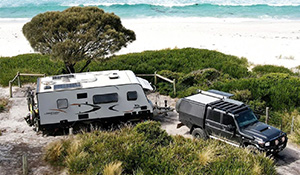ADVICE – Basic 4x4 Recovery Techniques
Words & Photos: PracticalMotoring.com.au
Driving off-road is a whole lot of fun and can be very safe - provided you know what you’re doing and where you’re going. The key to avoiding having to self-recover is to be aware of your surroundings.

Being aware of your surroundings means being mindful about following tracks around a boggy section of the trail, as this will just lead to the creation of another boggy section over time and result in another side track, or ‘chicken track’ being carved out and the environment suffering. If there’s nothing else for it, then use the side track, but ask yourself the question, ‘Do I really need to attempt this track on my own?’
Off-roading should be more about the destination rather than heading into the bush trying to find your 4x4’s limits and becoming stuck… especially when you’re on your own. Indeed, most of the photos in this article were only taken because we had a second, recovery vehicle nearby.
But let’s say you’ve decided to explore a side track on your own and have become stuck. Here are a few of the things you can try if you’re on your own with little or no recovery gear in the back of your 4x4.

Always use low-range in thick mud like this. Dropping the tyre pressures down to around 18-20psi is also recommended, but only if you have a way to reinflate them, like a portable air compressor.
Be like Bear Grylls…
The most important tool in your 4x4 recovery kit is your own brain and internet access on your smartphone. Always use the former, but the latter can be helpful when you run out of ideas.
And, above all else, don’t panic.

You’re driving a 4×4… so use everything it’s got
Use your vehicle the way it was intended. All modern 4×4 wagons, like the Ford Everest shown here, have different driving modes; but few are as advanced as the system in the Everest 4x4, so make the most of all the modes at your disposal.
Most proper four-wheel drives run similar driving mode options, but here’s a very brief explanation of how the modes In the Ford Everest work:
Normal – For on-road conditions and should be used on hard road surfaces, or once the need for any of the off-road modes has passed.
Mud/Snow/Grass – Use where a firm surface is covered with loose or slippery material. This includes gravel, shallow mud, wet grass or a snow-covered road.
Sand – Use for crossing deep sand or deep, sticky mud.
Rock – Gives low speed controllability for crawling over rocks. On the Everest, low range must be selected before this mode can be activated.

In the Everest 4x4, only Normal and Rock can be selected when the vehicle is in low-range, and it will not up-change from first-gear low in Rock mode – you need to manually select higher gears. As usual with mud/snow (and grass) modes, these are not suited for use in deep, soft conditions such as snow more than about 100mm deep or thick mud. Think of them more as ‘slippery surface’ modes, and that’s why Ford recommends Sand mode for driving across deep mud.
Sometimes, knowing which seemingly disconnected mode will work in the situation you’ve got yourself into is a case of trial and error. For example, did you know Rock mode is great in some sand driving situations?

The situation might require using, or not using, the rear-axle locking differential, using low range or not, but the first thing you should check is that the car is in its best 4WD mode.
If you’re driving an Everest 4x4, select the best drive mode, then make sure you’ve selected the correct Terrain Management Setting, too. You might have accidentally left it in Normal. Sometimes, locking the rear differential (if your vehicle has such a feature), or switching off the car and engaging four-wheel drive again can be the difference between remaining stuck and making it out.
Consult the vehicle’s owner’s manual, too. The manual for the Ford Everest 4x4 contains some very handy off-roading hints.
Alternatively, just keep trying different options, even if they seem silly.

Maximising your vehicle’s preparedness - by using the correct drive mode setting and engaging low-range when necessary - minimises your chance of becoming stuck.
Stuck in a dead end…
Quite often, when you’re driving off-road you can get stuck on a track that goes nowhere. In one case, I’ve had to reverse back down a track for more than two kilometres. There was no indication from my maps that there was a gate at the end of it… more than that, the track was overgrown and so turning around wasn’t an option without having to bulldoze a section of bush and scratch up the front and sides of my Ford Everest.
In the end, using a combination of the Everest’s reversing camera (a massive help in this scenario) and my mirrors, I could reverse back down the track slowly and carefully until I found a spot where I could turn around.
If you feel like the track is closing in or the going is becoming a little harder and the light is failing, then backing off and reversing back from where you are will have the effect of keeping you from getting stuck in the first place. The same applies to hill climbs or finding a path around that boggy section of mud instead of attempting to go through it.

Get your hands dirty
Sometimes, all it takes to help your vehicle clamber up and over an obstacle is a little bit of help. So, before you start to panic, get out of your car and have a look at the area that’s preventing progress.
It might be that a fist-sized rock placed in front of a wheel is enough to help the vehicle drive up and over. Building a ramp in front of each wheel is often the difference between remaining stuck and making it out. Use rocks rather than wood to build, as wood is slippery and can break and stake the tyre causing it to go flat, and then you’ll have another problem to deal with.
The key issues here will usually be ground clearance and traction. By building on the track, you can help stack the odds in your vehicle’s favour.
Fill in holes where the tyres spin and reduce the height of anything the car is grounding on. If you’re smart, you’ll do both at the same time. You may need to sacrifice the internal floor mats or other trim. If you’ve got one, some sort of duffle bag filled with rocks can also help; just make sure you place the bag where it needs to go and bring the rocks to it rather than filling it and trying to carry it to where it needs to be.

Stuck in soft sand… or mud
Lowering tyre pressures can often help your vehicle get the traction needed to get out of a sand trap. But, if you do decide to let the air out of your tyres and you don’t have a portable air compressor with you, then you’re going to need to be extremely careful. Let out enough air to flatten the tyre and get you unstuck, but then you need to remember to keep the speed down to avoid overheating your tyres and breaking the bead.
If you manage to make it out and back to the bitumen, it might be worth stopping and calling for someone to come and help with the portable air compressor you should have had in the back of your vehicle.
If you’re stuck in mud… well, you might end up having to get dirty. You can refer to the previous ‘track building’ ideas for help, but with mud, there’s almost no traction, so you can help your vehicle out by placing stuff at the front of the wheels to give them a bit of grip.
Another trick is to use reverse and then forward gear to try and rock your vehicle out of the mud, and see-saw at the steering wheel with the aim of trying to grab the side of the boggy ruts you’re in; these usually offer more grip and hopefully the tyre’s shoulder won’t have become caked with mud, allowing it to grab against the wall of the rut and help you to inch your way out of the bog. By steering side to side while driving forwards, it helps the tyres push the slick mud away and hopefully find a harder, grippier surface under the slippery stuff.
Lowering your tyre pressures, providing the tyre with a longer tread pattern and thus more grip, can also help.

If a track had not been cut through the grass around the bog, then the best advice would be to drive the bog and not risk damaging the environment, but preferably not when you’re on your own.
In the end…
Common sense and making use of your 4x4 to its full potential, like using the right Terrain Management Setting on the Ford Everest, will allow you to self-recover from most difficult situations. That said, investing in a basic recovery kit and leaving it in the back of your 4x4 will make life easier if you do get yourself stuck.
The final piece of advice - don’t ever head into the bush with only a quarter of a tank of fuel. You don’t want running out of fuel to be the reason you get stuck. When you're stranded a long way from anywhere and have just noticed you’ve got no phone reception, it’s much easier to build up a section of track than it is to find fuel …
NOTE: This article was originally produced in collaboration with Ford.









